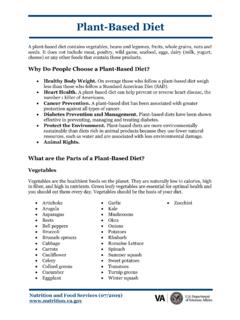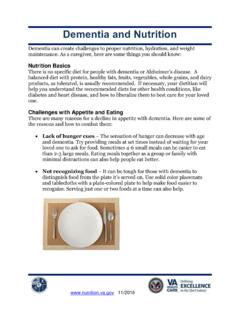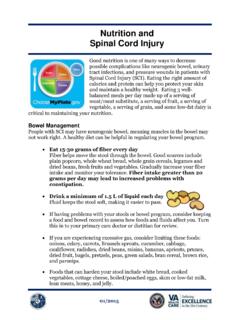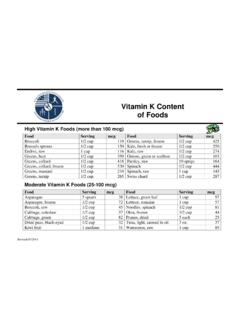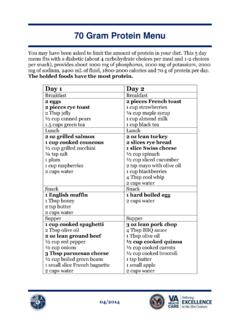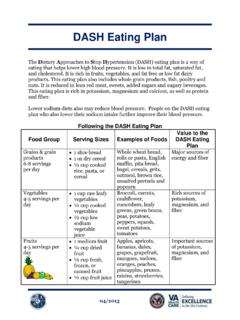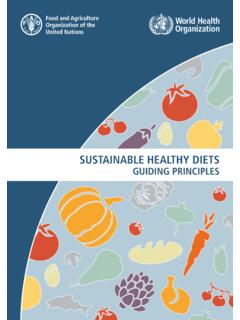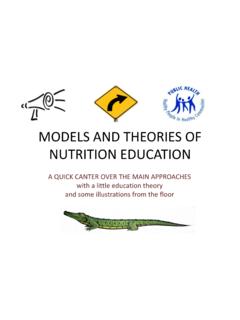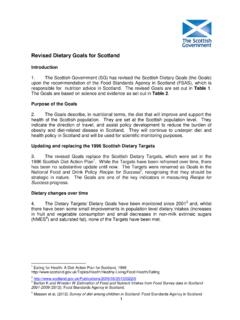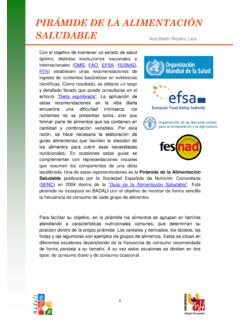Transcription of Omega 3 Fatty Acids: An Overview and Food Sources
1 09/2016 Omega -3 Fatty Acids: An Overview and food Sources Omega -3 Fatty acids are a form of polyunsaturated fat that our bodies use to keep the heart, brain, and eyes healthy. They are essential Fatty acids because we cannot make them on our own. We need to eat them in our diet . There are 3 types of Omega -3 Fatty acids: Eicosapentaenoic acid (EPA) Docosahexaenoic acid (DHA) Alpha linolenic acid (ALA) Our bodies easily use EPA and DHA. When we eat foods with ALA, our body uses an enzyme to change it to a usable form. Larger amounts of foods with ALA are needed to get the same health benefits as foods with EPA or DHA.
2 Benefits of Omega -3 Fatty Acids: Lowers triglycerides (a type of fat in the blood) Raises HDL (good cholesterol) Prevents blood clots Decreases inflammation Research Shows Omega -3 Fatty Acids May Also: Improve heart health Lower high blood pressure Maintain healthy eyes Improve rheumatoid arthritis Improve lupus Reduce risk of cancer Improve diabetes control Improve depression Improve Raynaud s disease Reduce risk of Alzheimer s 09/2016 2 food Sources of Omega -3 Fatty Acids: EPA and DHA are found in cold-water fish like tuna, sardines, salmon, mackerel whitefish and herring.
3 Prepare these foods by baking, broiling or grilling. Limit frying or using heavy butter sauces. Aim for one checkbook-size portion of fish, twice per week. ALA is found in dark green leafy vegetables, soy, flaxseed, chia seed, walnuts, and vegetable oils such as canola. Eat a variety of these foods to gain the many health benefits that Omega -3 Fatty acids can offer. Mercury Mercury is a toxic substance entering our waters as a waste product from coal burning plants and iron mining. Fish absorb mercury directly from the water. Larger fish are exposed to higher levels of mercury because their prey also absorbs mercury.
4 Mercury binds tightly to the proteins in fish, including muscle, and builds up in Fatty tissues. Cooking does not reduce the mercury content of the fish. Mercury can directly affect the human central nervous system and can be fatal in extreme cases. Symptoms of Mercury Poisoning: Numbness and tingling around the lips, fingers and toes Difficulty walking and difficulty speaking Impaired vision or hearing Muscle weakness, fatigue, headache, irritability Inability to concentrate Tremors or jerky muscle movements 09/2016 3 Mercury Guidelines Nearly all fish contain trace amounts of mercury, some more than others.
5 In a 2014 report, the Federal food and Drug Administration (FDA) and Environmental Protection Agency (EPA) concluded pregnant and breastfeeding women, those who might become pregnant, and young children should eat more fish that is lower in mercury in order to gain important developmental and health benefits. The report advises pregnant or breastfeeding women to avoid four types of fish that are associated with high mercury levels: Tilefish from the Gulf of Mexico Shark Swordfish King mackerel Albacore Tuna, limit to 6 ounces per week When eating fish caught from local streams, rivers and lakes, follow fish advisories from local authorities.
6 If advice isn t available, limit your total intake of such fish to 6 ounces a week and 1-3 ounces for children. Avoid fish oil capsules. Techniques to remove mercury & industrial pollutants are often ineffective. The toxins build up in the Fatty tissues of fish and become concentrated in fish oil supplements. Top Non-Fish Sources of Omega -3 Fatty Acids Leafy greens (collard, kale, spinach, mustard, turnip) Nuts (cashew, walnuts) Seeds (ground flaxseed, hemp, chia, pumpkin) Oils (flaxseed, walnut, canola, olive, hemp) Tofu Other (avocado, summer squash, Brussel sprouts, winter squash, ground cloves, ground oregano, peppermint leaves, mustard seeds) 09/2016 4 Joint FAO/WHO expert consultation on the Risks and Benefits of Fish Consumption.
7 Patterson Clark/The Washington Post. April 3rd, 2012.
